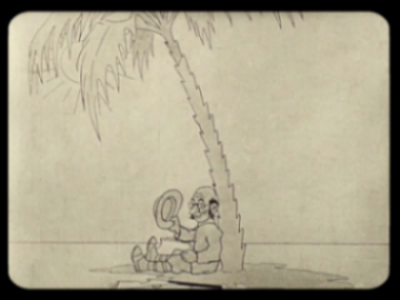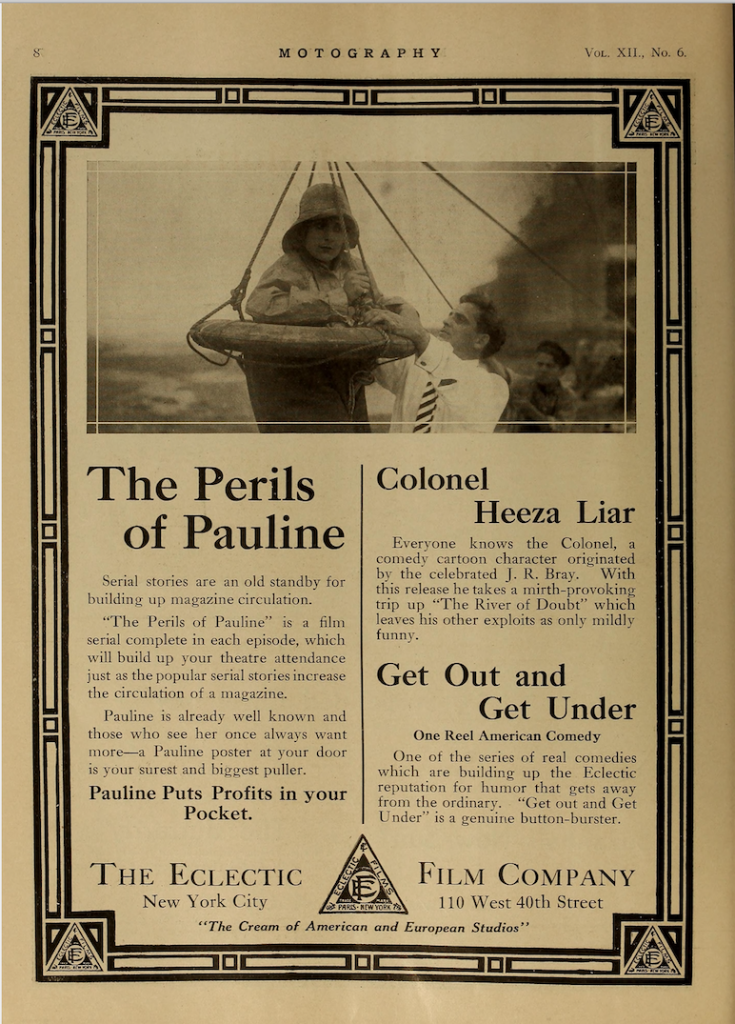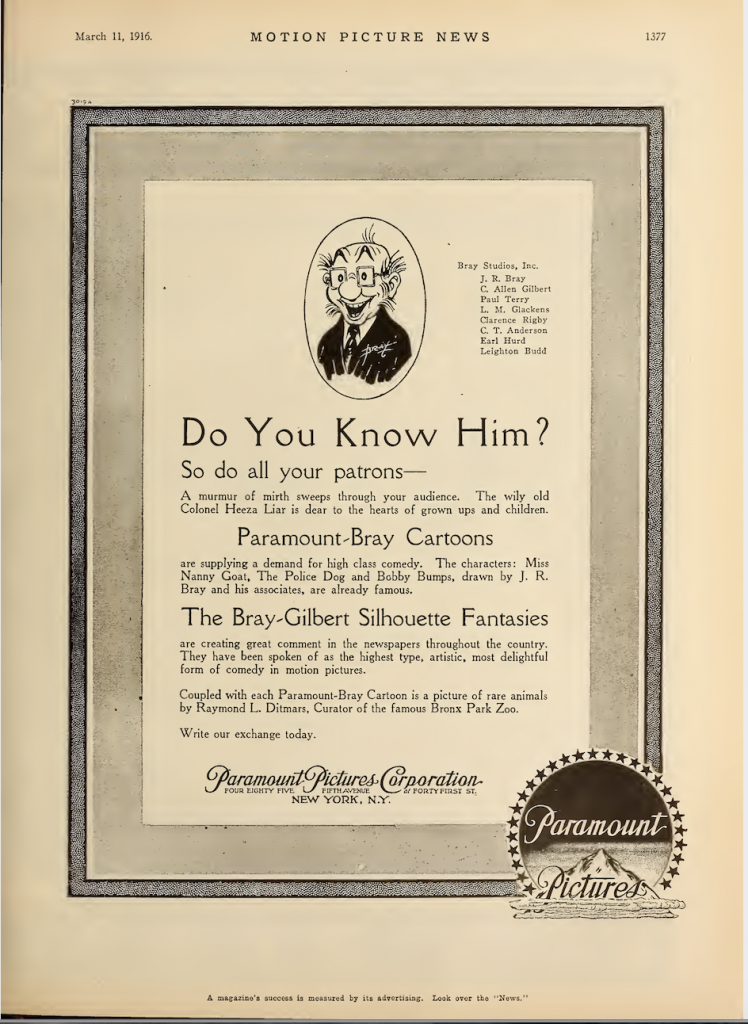
Winsor McCay’s Little Nemo (1911), How a Mosquito Operates (1912), and Gertie the Dinosaur (1914) are regularly singled out as the most significant achievements in American animation of the early 1910s, often in comparison to the apparent deficiencies of other contemporary producers. This post suggests that the Bray Studio’s cel-animated Colonel Heeza Liar series provided another valuable contribution to the same era, particularly in its recurring articulation of the cartoon protagonist.
In my upcoming book Animated Personalities: Cartoon Characters and Stardom in American Theatrical Shorts, I argue that Colonel Heeza Liar offers a parallel to Richard deCordova’s notion of the live-action “picture personality”[1]. DeCordova emphasizes a distinction between “legitimate” actors, whose fame from stage performances preceded their appearances in films, and the rise of picture personalities, whose identities were “produced and maintained largely by the cinema itself”[2]. Colonel Heeza Liar was created specifically for the screen, at a time when most cartoon makers were reliant upon the adaptation of pre-established newspaper comic strips. The success of the Colonel helped to usher in a culture of developing original characters for animated series: a production mode that anticipates the rise of protagonists such as Felix the Cat and Mickey Mouse.
The continued popularity of these later figures, compared to the general obscurity of Colonel Heeza Liar today, has perhaps served to downplay the importance of the early silent era. This was arguably compounded by retrospective interviews with surviving personnel, undertaken in the latter decades of the twentieth century. The veteran artist Dick Huemer, for instance, offered the following summary of his experiences of making cartoons in the 1910s:
I can remember taking my family to see some bit of animation I was particularly proud of, and just as it went on, somebody behind me said, “Oh, I hate these things.” […] It was just not understandable to audiences very often. […] If the exhibitor hated cartoons, he didn’t run them. That’s how interested they were.[3]
Huemer’s status within the industry, and the candid nature of his remarks, lends credence to his description, but it is problematic to summarize comprehensively the audience response to cartoons based on this single account – relayed decades after the period in question, and often juxtaposed against Huemer’s subsequent achievements at Disney. The presentation of Colonel Heeza Liar’s films in the fan and trade magazines of the period offer a very different account. While it does have to be acknowledged that much of this material was intended to be promotional – with even film reviews and exhibitor reports not beyond the realm of coercion or fabrication – the sheer volume of discussion about the character emphasizes that animation was by no means invisible or ignored at this time.
Bray’s first film with the Colonel was Colonel Heeza Liar in Africa (1913), establishing the character as an elderly man, who – as his pun-based name implies – is often willing to exaggerate his own achievements. Production of an ongoing series commenced in the following year, and publicity quickly placed an emphasis upon the apparent notoriety that the character had developed[4]. As early as 1914, the Eclectic Film Company in New York was using the phrase “Everyone knows the Colonel” in their advertising (see fig. 2)[5].

In 1916, Paramount Pictures – which had recently picked up nationwide distribution rights to the films – placed the following copy in several trade magazines (fig. 3):
Do You Know Him?
So do all your patrons –
A murmur of mirth sweeps through your audience. The wily old Colonel Heeza Liar is dear to the hearts of grown ups and children.[6]

It is even possible to find advertisements and articles that outline the plots of several past Heeza Liar films, phrased with the assumption that the contemporary reader would be familiar with all of these different entries[7]. This responds to deCordova’s notion of audiences making “intertextual connections between films”, because of their knowledge of, and interest in, the cinematically-generated picture personality[8].
It may be difficult for present-day viewers to immediately comprehend the appeal that these cartoons may once have had. In the surviving examples of the early Heeza Liar cartoons, the number of new drawings per second is often painfully low, and there is frequent recycling of action. When I screen Colonel Heeza Liar at the Bat (1915) in my animation history class, for instance, it sometimes generates a form of metatextual laughter. For the young animators in the room, the level of repetition in Bray’s work – most notably involving the Colonel turning to the “camera” and winking at the audience (fig. 4) – can now appear ridiculous.

There is, however, little evidence that the aesthetics of the Heeza Liar films were widely criticized upon initial release. One 1916 article even attempts to make a virtue of the cycling process, suggesting that seeing an action several times allows one to comprehend “the immense amount of detailed [work]” that went into each drawing[9]. Donald Crafton offers a convincing argument that the repetition in these early shorts may also have helped to imply “film-to-film consistency and encouraged the spectator to place the character in his fictive universe”[10]. In lieu of more detailed animation, recurring gestures thus seemingly played a valuable role in establishing broad personality traits for the Colonel. These economies also facilitated a faster production schedule, with new entries in the series usually appearing at least once a month during 1915 and 1916 – another important factor in establishing widespread brand awareness of the Colonel Heeza Liar franchise.
DeCordova positions the “picture personality” as a transitional stage, in which audience interest in the performer was still largely confined to the image projected by his or her films[11]. Colonel Heeza Liar fits into this category because there was generally little attempt to construct his off-screen “existence.” This contrasts with later animated “stars” such as Felix the Cat and Mickey Mouse, who were increasingly shown endorsing products, granting interviews in fan magazines, and so on. One of the few instances in which the Colonel was evoked as a “private” individual occurred in a feature for the Exhibitors Trade Review in 1924:
Gee! I’ve been working around the Bray Studios for twelve years now, and am the oldest cartoon in existence. […]
Look what’s happened to the other Bray characters. Bobby Bumps has grown up, and is a big boy now; Goodrich Dirt, the famous tramp, became a war profiteer and is living on Fifth Avenue. He’s quit the movies too. […]
Of all the Bray cartoons I am the only one that is still working. I wish Bray would give me a vacation.[12]
Ironically, the desired “vacation” proved permanent, as the Heeza Liar series was quietly discontinued shortly after the article’s publication, replaced by a new Bray production entitled Dinky Doodle (1924-1926). While a “comeback” is always possible in animation – note, for instance, the recent acquisition of Felix the Cat by DreamWorks – almost a century has passed since the Colonel last headlined a cartoon. Heeza Liar nonetheless embodies a crucial period of animation history: one in which the medium moved from its early stages of technological experimentation and novelty, towards an industrial process profitably led by a marketable central character.
David McGowan is a lecturer in animation history at the Savannah College of Art and Design (SCAD). His first book, Animated Personalities: Cartoon Characters and Stardom in American Theatrical Shorts, is due for release in early 2019 by the University of Texas Press. He is an alumnus of the University of Warwick and Loughborough University.
[1] McGowan, David, Animated Personalities: Cartoon Characters and Stardom in American Theatrical Shorts (Austin: University of Texas Press, 2019); deCordova, Richard, Picture Personalities: The Emergence of the Star System in America, rev. ed (Urbana: University of Illinois Press, 2001).
[2] deCordova, Picture Personalities, 50-51.
[3]Huemer in Adamson, Joe, “A Talk with Dick Huemer,” in Danny Peary and Gerald Peary (eds.), The American Animated Cartoon: A Critical Anthology (New York: E. P. Dutton, 1980), 31-32.
[4] There are two distinct periods to the Colonel’s “career.” His initial run of short cartoons lasted until 1917. The character returned to the screens in late 1922, with this new strand taking the form of the combination cartoon – films that mixed hand-drawn animation with live-action footage – inspired by the Fleischers’ success with the Out of the Inkwell series.
[5] Motography 12.6 (8 August 1914): 8.
[6] Motion Picture News 13.10 (11 March 1916): 1377.
[7] See, for instance, “Animated Cartoons in Motion Pictures,” Moving Picture World 24.1 (3 April 1915): 54.
[8] deCordova, Picture Personalities, 90.
[9] Hirshberg, Dr. Leonard Keene, “Cartoons that Move and Act,” Motion Picture Magazine 11.3 (April 1916): 45.
[10] Crafton, Donald, Before Mickey: The Animated Film, 1898-1928, rev. ed (Chicago: University of Chicago Press, 1993), 272.
[11] deCordova, Picture Personalities, 86.
[12] Kopfstein, Jacques, “Comedy Gets a New Character,” Exhibitors Trade Review (16 August 1924): 30.

happy holi to all
Hi, this is a first-time commenter posting. I’ve always been interested in learning about history, the history of cartoons being one of them. I was very excited when I came across this blog for the first time today. This isn’t the first post I’ve read on here, but I was very interested in reading it, since I know very little about early silent animation other than Winsor McKay, and next to nothing about Heeza Liar.
However, and please keep in mind that I mean no disrespect, that I find the vocabulary used by the authors of the articles that I’ve read to be alienating, and this article especially.
For example: “[…] its recurring articulation of the cartoon protagonist.” Was the word “articulation” really necessary? I’ve looked up the dictionary definition on Merriam-Webster.com, and I’m still not clear on what you’re trying to tell the reader. In the same vein, Richard deCordova’s use of the word “intertextual (“notion of audiences making ‘intertextual connections between films'”) is unnecessarily unclear. Even worse is Donald Crafton’s use of the word “fictive”. Does Mr. Crafton find the word “fictional” to be too common? I had planned on looking up his book “Before Mickey” before I read this, but if this is his vocabulary throughout the book, I think I’ll have to skip it. Finally, I tried to look up the definition of “metatextual”, but Merriam-Webster, the standard American dictionary, doesn’t even recognize it as a word.
Again, please understand that I mean no disrespect, but this blog, and this article in particular, leans a little too close to academic jargon for me. I’m disappointed; I was beginning to learn quite a bit before it all built up and formed a mental and anxiety-producing wall.
Thank you for your time and for considering my comment.
David, thanks for your terrific research here. It was great to see how you’ve demonstrated there was a casual assumption in the trades that the Col. was a recognized cartoon ‘star’, which is my understanding, though I’m in agreement he’s now become obscure. I look forward to your book coming out shortly and I’ll have it on pre-order.
During the period of Heeza Liar’s run, there was another Bray series that rivaled it in terms of popularity: the Bobby Bumps series created by Earl Hurd. It begun shortly after the Col. began and ended a little before it, though the argument can easily be made that B.Bumps had a more consistent run, without a gap in the middle. There’s basically a five-year stretch of no Heeza Liar production.
So, even though from a modern perspective we don’t generally debate or delineate how popular the pre-Felix cartoon stars were (relative to each other), I have sometimes wondered if there was nonetheless a perceived pecking order or a more widely-held favorite at the time. Certainly young Walt Disney had a preference. He preferred Bobby Bumps the best of all the early series cartoons.
So, I was curious to know: did you find any evidence to support a notion of whether Bobby or the Colonel was the bigger star? (during the height of their popularity about a hundred years ago)
Hi Tom,
Thanks for the reply, and the kind words about the post. There is a good amount of evidence – at least, as I mention above, as much as the fan magazines can be trusted as evidence – that Bobby Bumps was also a popular character with audiences. As you say, he enjoyed a more consistent run of releases, compared to Heeza Liar’s disappearance in the late 1910s and reappearance in the following decade. In 1920, when Felix the Cat’s star began to rise, the Moving Picture World listed Bobby Bumps as the only animated protagonist to still enjoy greater fame – although they did then spell his name wrong in the article! (http://lantern.mediahist.org/catalog/movpicwor432movi_1225). I think there’s definitely a need for more research into Bobby Bumps, especially as more of his films appear to have survived compared to Heeza Liar’s. I’m particularly looking forward to Tom Stathes’ upcoming Blu-ray/DVD collection of Bumps films – I can imagine the opportunity to see many of these films in HD, compared to the murky copies I’ve accessed in the past, will be an excellent opportunity to revisit the character’s contribution to early animation history (https://www.indiegogo.com/projects/historic-bobby-bumps-cartoons-on-blu-ray-dvd).
As far as I can tell, though, Heeza Liar was evoked more often as a “picture personality” (or proto-star) than Bobby Bumps. The Bumps publicity pieces generally seem to be more focused on relating the material back to the character’s creator, Earl Hurd, and don’t always seem as interested in presenting Bumps as a distinct “individual” compared to Heeza Liar or many later characters. At least one article even suggests that Bumps was based on Hurd’s own child (http://lantern.mediahist.org/catalog/filmfun334345lesl_0414). This may in itself be an interesting reflection of the business relationship between Hurd and Bray. There doesn’t seem to be a lot of research yet undertaken about how the two interacted professionally, or how Hurd felt about his films being released by the “Bray” studio, despite their shared credit for the cel animation patents.